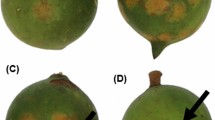Summary
Effects on yield and quality associated with the glabrous leaf, frego bract, okra leaf and nectariless genes (singly and combined) were studied under two insecticide spray regimes (heavy and light) in field experiments repeated over three seasons. Under the heavy spray regime there were few consistent differences between mutant genotypes and the normal except for low yields associated with the glabrous leaf, nectariless, frego bract genotype and the okra leaf genotype. Under the light spray regime, genotypes containing the okra leaf gene and/or the nectariless genes were associated with higher yields than the normal and genotypes containing glabrous leaf and/or frego bract genes were associated with lower yields. Positive epistatic interactions occurred in a number of instances including the okra leaf gene in the glabrous hair, normal bract background under heavy spraying, and with all backgrounds under light spraying, and for glabrous leaf in both the okra normal and okra frego backgrounds under heavy spraying. Nectariless also interacted positively with the normal leaf, normal hair, normal bract background under light spraying. Pronounced negative epistatic interactions only occurred in the light spray regime, and included glabrous leaf in all backgrounds, and frego bract in all backgrounds except the normal leaf, normal hair. The mutant genes had only minor effects on lint quality. The implications of the results for breeding and pest management are diseussed.
Similar content being viewed by others
References
Adjei-Maafo, I. K., L. T. Wilson, N. J. Thomson & P. R. B. Blood, 1983. Effect of pest damage intensity on the growth, maturation and yield of nectaried and nectariless cottons. Environ. Ento. 12: 353–358.
Anon., 1967. American Society for Testing and Materials, Committee D-13. ASTM Standards on Textile Materials, Philadelphia.
Benedict, J. H., T. F. Leigh, A. H. Hyer & P. F. Wynholds, 1981. Nectariless cotton: effect on growth, survival and fecundity of lygus bugs. Crop Sci. 21: 28–30.
Brettell, J. H., 1980. Prospects for arthropod pest control utilizing cotton plant resistance. Proc. Cott. Pest Cont. Workshop, Nelspuit, So. Afr. 19–26.
Burris, E., H. C. Kinard, K. J. Ratchford, D. F. Clower & J. E. Jones, 1981. Plant bug complex as affected by cotton genotypes. Proc. Beltwide Cotton Prod. Res. Conf. p. 61.
Ewing, E. C. Jr., E. L. Gilbert & W. E. Bradford, 1958. The cleaning of smooth-leaved cottons. Proc. Beltwide Cotton Prod. Res. Conf. p. 63.
Jones, J. E., 1982. The present state of the art and science of cotton breeding for leaf-morphological types. Proc. Beltwide Cotton Prod. Res. Conf. p. 93–99.
Jones, J. E., D. F. Clower, E. Burris, J. G. Marshall & S. J. Stringer, 1983. Progress in breeding fregonectariless cottons for reduced plant bug sensitivity. Proc. Beltwide Cotton Prod. Res. Conf. p. 81–83.
Jones, J. E., D. F. Clower, M. R. Milan, W. D. Caldwell & D. R. Melville, 1975. Resistance in upland cotton to the banded-winged whitefly, Trialeurodes abutilonea Halderman. Proc. Beltwide Cotton Prod. Res. Conf. p. 98.
Lee, J. A., 1984. Effects of plant smoothness on agronomic traits of upland cotton — fibre properties. Crop Sci. 24: 716–720.
Lincoln, C., G. Dean, B. A. Waddle, W. C. Yearian, J. R. Phillips & L. Roberts, 1971. Resistance of frego-type cotton to boll weevil and bollworms. J. Econ. Entomol. 64: 1326–1327.
Lukefahr, M. J., J. E. Houghtaling & J. W. Graham, 1971. Suppression of Heliothis populations with glabrous cotton strains. J. Econ. Entomol. 64: 486–488.
Meredith, W. R. 1982. Cotton yield interactions for normal vs okra leaf isolines. Agron. Abs. p. 76.
Meredith, W. R. 1983. Effects of environments and genetic backgrounds on evaluation of cotton isolines. Crop Sci. 23: 51–54.
Meredith, W. R., C. R. Ranney, M. L. Laster & R. D. Bridge, 1973. Agronomic potential of nectariless cotton. J. Environ. Qual. 2: 141–144.
Meredith, W. R. & M. F. Schuster, 1979. Tolerance of glabrous and pubescent cottons to tarnished plant bug Crop. Sci. 19: 484–488.
Reid, P. E. & N. J. Thomson, 1984. Changes in growth and development in cotton associated with genes for frego bract and glabrous leaf. Aust. J. Exp. Agric. Anim. Husb. 24: 426–432.
Weaver, J. B.Jr. & T. Wofford, 1980. Reduction in bract trash in lint through the development of small normal bract and frego bract genotypes. p. 62–3. In: P. J. Wakelyn (Ed.), Proc. Fourth Special Session on Cotton Dust Res. at the Beltwide Cotton Prod. Res. Conf., 8–10 Jan. 1980. Natl. Cotton Coun., Memphis, Tenn.
Wilson, F. D. & B. W. George, 1981. Breeding cotton for resistance to pink bollworm. Proc. Beltwide Cotton Prod. Res. Conf. pp. 63–65.
Author information
Authors and Affiliations
Rights and permissions
About this article
Cite this article
Thomson, N.J., Reid, P.E. & Williams, E.R. Effects of the okra leaf, nectariless, frego bract and glabrous conditions on yield and quality of cotton lines. Euphytica 36, 545–553 (1987). https://doi.org/10.1007/BF00041501
Received:
Issue Date:
DOI: https://doi.org/10.1007/BF00041501




